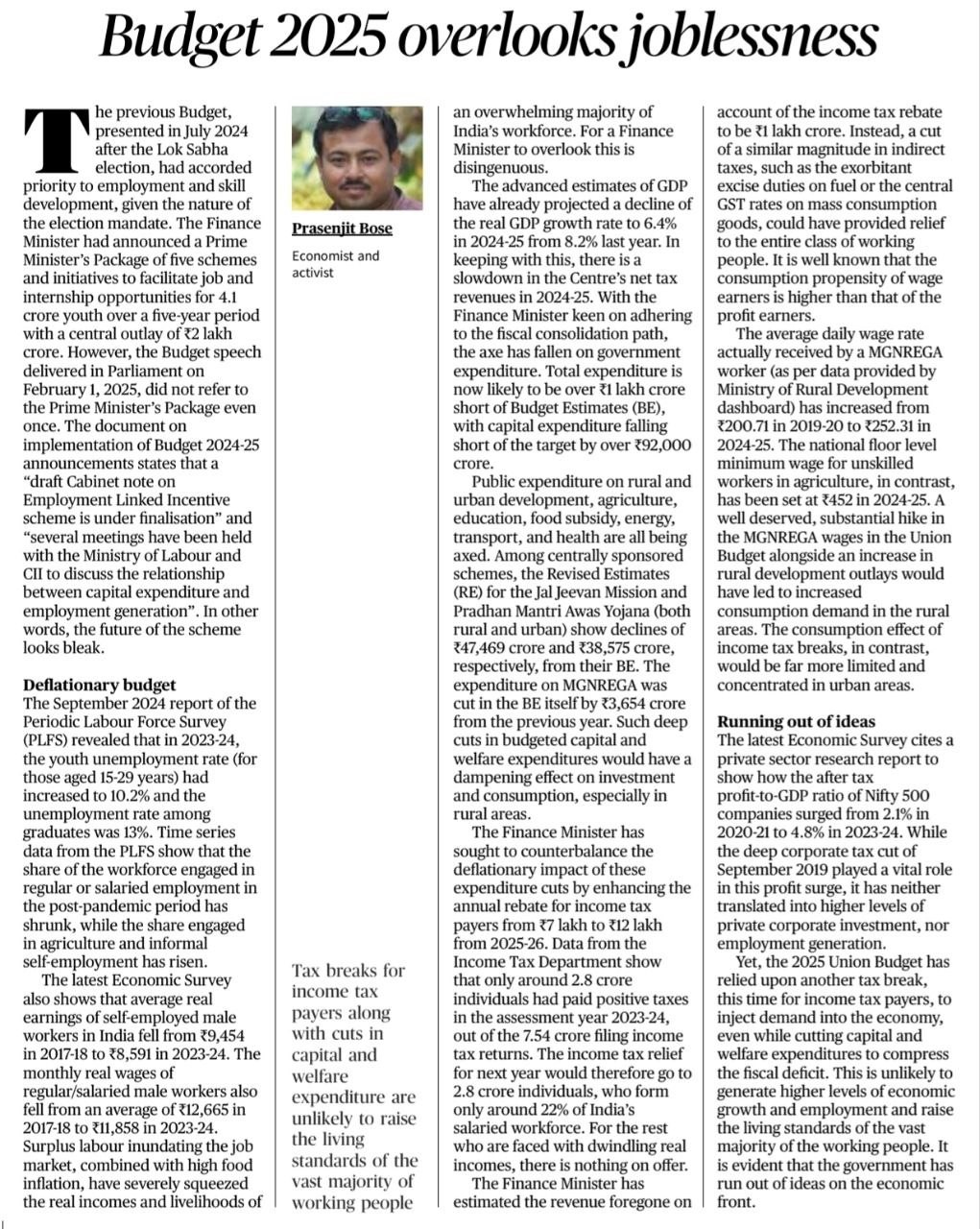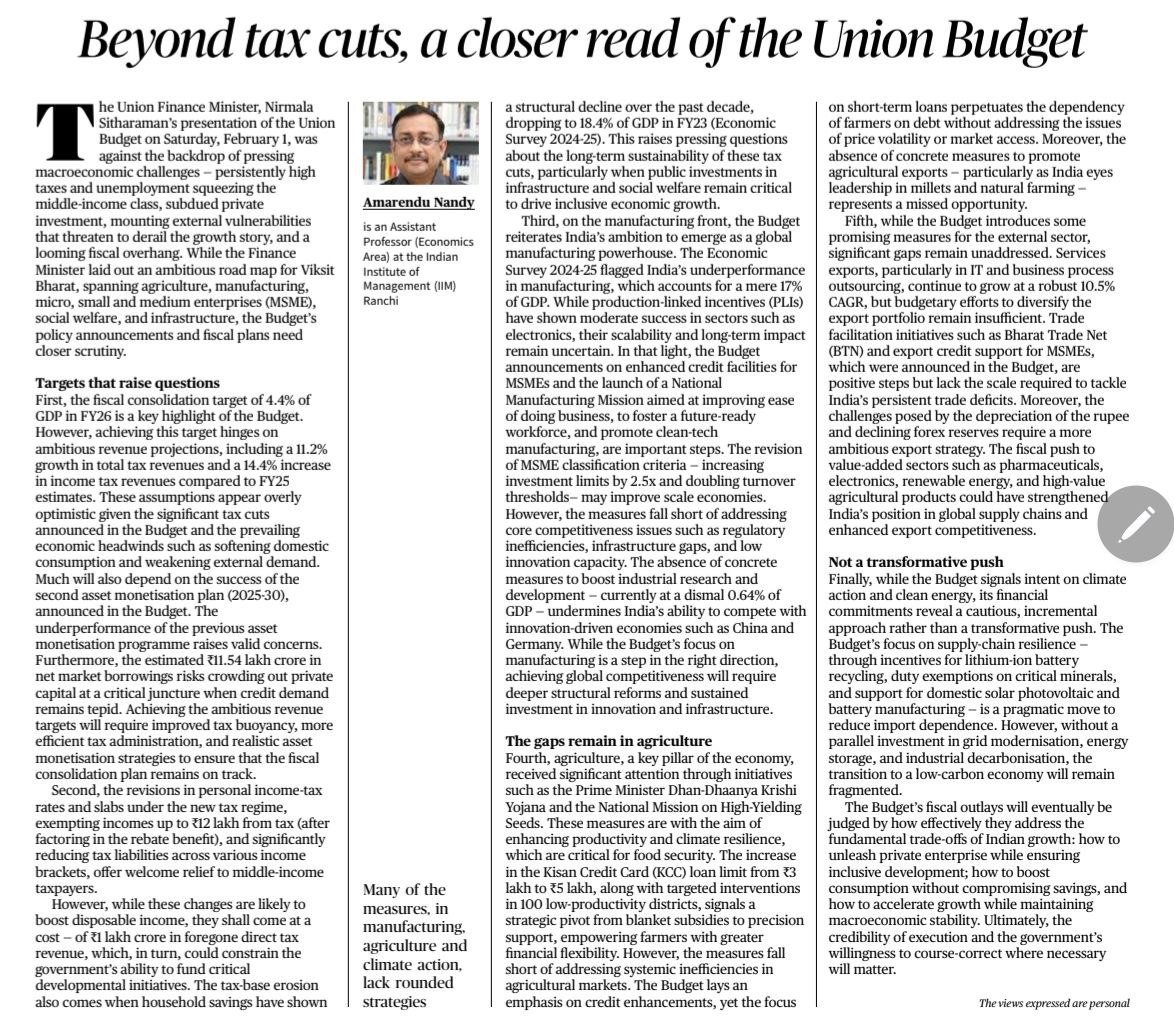1. Budget 2025 and the Joblessness Crisis
Introduction
The Budget 2025, presented after the July 2024 Lok Sabha elections, has overlooked employment and skill development despite the Finance Minister’s earlier promise of initiatives under the Prime Minister’s Package. The economic slowdown and fiscal constraints have led to a deflationary budget that neglects job creation and social welfare, raising concerns about its impact on the working class and rural economy.
- Deflationary Budget and Its Impact
- Decline in Government Spending: Capital expenditure falls short by ₹92,000 crore, impacting infrastructure and job creation.
- Youth Unemployment: Periodic Labour Force Survey (PLFS) 2024 reports a youth unemployment rate of 10.2%, with graduate unemployment at 13%.
- Declining Wage Growth: Earnings of salaried male workers fell from ₹9,454 in 2017-18 to ₹8,591 in 2023-24, leading to lower disposable income and demand.
- Reduced Welfare and Public Expenditure
- Cuts in Rural and Urban Development: Decline in expenditures on MGNREGA, rural employment (PMAY, JJM), and agricultural support.
- Dampening Effect on Consumption: Reduction in welfare schemes lowers spending, affecting rural and urban demand.
- Taxation Policy and Economic Growth
- Tax Breaks for Income Tax Payers: Increase in exemption from ₹7 lakh to ₹12 lakh, benefiting only 2.8 crore individuals, leaving the majority of working-class people unaffected.
- Corporate Tax Reduction: The 2019 tax cut increased profits for companies but failed to boost private investment or job creation.
- Limited Effect on Employment and Growth
- Minimal Wage Hikes: MGNREGA wage increased from ₹200.7 in 2019-20 to ₹252.31 in 2024-25, but still insufficient to counter inflation.
- Agricultural Sector Wages: Floor wages set at ₹452 in 2024-25, not enough to significantly improve rural income levels.
Conclusion
The Budget 2025 reflects a lack of vision in addressing joblessness and income disparity. While tax cuts and fiscal consolidation remain the focus, they fail to translate into higher employment and economic growth. A more balanced approach with increased public investment and rural employment schemes is necessary to support India’s workforce and boost demand-driven economic recovery.
Bottom of FormMains Practice Question |
Q. The Budget 2025 focuses on fiscal consolidation but overlooks employment generation and social welfare. Analyze its implications on economic growth and income inequality in India. |
2. Budget 2025: A Growth-Oriented and Forward-Looking Approach
Introduction
The Union Budget 2025-26 aligns with the government’s strategy to drive economic growth through fiscal prudence, capital expenditure, and sectoral development. Key highlights include personal income tax cuts, increased infrastructure spending, and support for labor-intensive industries. The budget aims to create a virtuous cycle of consumption, investment, and employment.
- Key Highlights of Budget 2025
- Personal Income Tax Cuts
- Complete exemption for individuals earning up to ₹12 lakh per year.
- Expected to boost middle-class disposable income and increase demand.
- Increased Capital Expenditure
- Allocation of ₹11.2 lakh crore, marking a 10% increase from the previous year.
- Focus on infrastructure development to catalyze economic activity.
- Manufacturing and Industrial Growth
- Launch of the National Manufacturing Mission under the ‘Make in India’ initiative.
- Emphasis on reducing import dependency and encouraging foreign investment.
- Support for Employment and Labour-Intensive Sectors
- Focus on Labour-Intensive Industries
- Increased incentives for sectors like tourism, food processing, and textiles.
- Streamlining regulations and trade facilitation to enhance competitiveness.
- Maritime and Trade Infrastructure
- Maritime Development Policy to improve port efficiency and logistics.
- Blue Economy initiatives to boost marine trade and coastal employment.
- Fiscal Prudence and Economic Stability
- Fiscal Deficit Reduction
- Target to lower the fiscal deficit from 8% in 2024-25 to 4.4% in 2025-26.
- Expected to improve investor confidence and macroeconomic stability.
- Ease of Doing Business
- Tariff rationalization by removing redundant surcharges.
- Simplification of tax frameworks to encourage domestic and foreign investment.
Conclusion
The Budget 2025 presents a balanced approach, integrating fiscal prudence with growth-focused initiatives. While it supports consumption, infrastructure, and industrial development, its effectiveness in job creation and social welfare needs continuous assessment. The success of these measures will depend on their timely implementation and adaptability to economic challenges.
Mains Practice Question |
Q. “The Budget 2025 aims to promote economic growth through tax cuts, infrastructure investment, and fiscal prudence. Critically evaluate its impact on employment and income distribution.” |
3. Union Budget 2025: A Closer Look at Growth, Taxation, and Challenges
Introduction
The Union Budget 2025, presented against the backdrop of economic challenges such as high unemployment, subdued private investment, and fiscal consolidation, aims to drive growth through tax reforms, infrastructure development, and manufacturing incentives. However, concerns remain regarding the sustainability of revenue projections, the effectiveness of policy measures, and the long-term impact on key sectors like agriculture, MSMEs, and clean energy.
- Key Highlights and Fiscal Strategy
- Fiscal Deficit Target
- Reduction to 4% of GDP in FY26, but concerns about feasibility given tax cuts.
- Optimistic revenue projections (11.2% growth in total tax revenue).
- Tax Reforms
- Increase in income tax exemption to ₹12 lakh.
- Potential decline in government revenue affecting social welfare and capital spending.
- Impact on Manufacturing and MSMEs
- Manufacturing Growth
- Economic Survey highlights underperformance of the sector (17% of GDP).
- Production-linked incentives (PLIs) have had mixed success.
- MSME Sector Support
- Enhanced credit facilities and revised MSME classification.
- Concerns over regulatory inefficiencies and lack of targeted innovation policies.
- Agricultural Reforms and Rural Development
- Credit and Subsidy-Based Approach
- Focus on farm credit rather than structural reforms.
- Lack of measures to address price volatility and market inefficiencies.
- Investment in Sustainable Farming
- Push for climate-resilient agriculture and millet production.
- Increase in Kishan Credit Card (KCC) loan limit to ₹3 lakh.
- Energy and Climate Commitments
- Incremental Climate Strategy
- Budget promotes clean energy and electric mobility.
- Limited financial commitments for green infrastructure.
- Infrastructure Development
- Continued emphasis on roads, railways, and logistics to boost trade.
- Concerns over underperformance of asset monetization programs.
Conclusion
While the Budget 2025 introduces growth-focused measures, challenges remain in sustaining revenue, implementing structural reforms, and ensuring inclusive economic growth. The success of the budget will depend on effective execution, policy flexibility, and addressing gaps in agriculture, manufacturing, and social welfare.
Mains Practice Question |
Q. “The Union Budget 2025 aims to balance fiscal consolidation with economic growth. Critically examine its impact on key sectors like manufacturing, agriculture, and employment.” |




